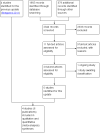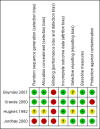Hospital at home: home-based end-of-life care
- PMID: 26887902
- PMCID: PMC7111432
- DOI: 10.1002/14651858.CD009231.pub2
Hospital at home: home-based end-of-life care
Update in
-
Hospital at home: home-based end-of-life care.Cochrane Database Syst Rev. 2021 Mar 16;3(3):CD009231. doi: 10.1002/14651858.CD009231.pub3. Cochrane Database Syst Rev. 2021. PMID: 33721912 Free PMC article.
Abstract
Background: The policy in a number of countries is to provide people with a terminal illness the choice of dying at home. This policy is supported by surveys indicating that the general public and people with a terminal illness would prefer to receive end-of-life care at home. This is the fourth update of the original review.
Objectives: To determine if providing home-based end-of-life care reduces the likelihood of dying in hospital and what effect this has on patients' symptoms, quality of life, health service costs, and caregivers, compared with inpatient hospital or hospice care.
Search methods: We searched the following databases until April 2015: Cochrane Central Register of Controlled Trials (CENTRAL) (the Cochrane Library), Ovid MEDLINE(R) (from 1950), EMBASE (from 1980), CINAHL (from 1982), and EconLit (from 1969). We checked the reference lists of potentially relevant articles identified and handsearched palliative care publications, clinical trials registries, and a database of systematic reviews for related trials (PDQ-Evidence 2015).
Selection criteria: Randomised controlled trials, interrupted time series, or controlled before and after studies evaluating the effectiveness of home-based end-of-life care with inpatient hospital or hospice care for people aged 18 years and older.
Data collection and analysis: Two review authors independently extracted data and assessed study quality. We combined the published data for dichotomous outcomes using fixed-effect Mantel-Haenszel meta-analysis. When combining outcome data was not possible, we reported the results from individual studies.
Main results: We included four trials in this review and did not identify new studies from the search in April 2015. Home-based end-of-life care increased the likelihood of dying at home compared with usual care (risk ratio (RR) 1.33, 95% confidence interval (CI) 1.14 to 1.55, P = 0.0002; Chi(2) = 1.72, df = 2, P = 0.42, I(2) = 0%; 3 trials; N = 652; high quality evidence). Admission to hospital while receiving home-based end-of-life care varied between trials, and this was reflected by a high level of statistical heterogeneity in this analysis (range RR 0.62 to RR 2.61; 4 trials; N = 823; moderate quality evidence). Home-based end-of-life care may slightly improve patient satisfaction at one-month follow-up and reduce it at six-month follow-up (2 trials; low quality evidence). The effect on caregivers is uncertain (2 trials; low quality evidence). The intervention may slightly reduce healthcare costs (2 trials, low quality evidence). No trial reported costs to patients and caregivers.
Authors' conclusions: The evidence included in this review supports the use of home-based end-of-life care programmes for increasing the number of people who will die at home, although the numbers of people admitted to hospital while receiving end-of-life care should be monitored. Future research should systematically assess the impact of home-based end-of-life care on caregivers.
Conflict of interest statement
BW is a full‐time salaried employee of the National Health Service in the UK. Her responsibilities include the provision of specialist palliative care services (in the hospice, community, and hospital), service development, education, and research in palliative care. Neither she, nor her organisation, stands to gain or lose from the conclusions of this review, but like other services within the National Health Service, the conclusions of this review may inform future service development or commissioning, or both.
DCGB: none. SS: none. SES: none.
Figures








Update of
-
Hospital at home: home-based end of life care.Cochrane Database Syst Rev. 2011 Jul 6;(7):CD009231. doi: 10.1002/14651858.CD009231. Cochrane Database Syst Rev. 2011. Update in: Cochrane Database Syst Rev. 2016 Feb 18;2:CD009231. doi: 10.1002/14651858.CD009231.pub2. PMID: 21735440 Free PMC article. Updated.
References
References to studies included in this review
Brumley 2007 {published data only}
-
- Brumley R, Enguidanot S, Jamison P, Seitz R, Morgenstern N, Saito S, et al. Increased satisfaction with care and lower costs: results of a randomized trial of in‐home palliative care. Journal of the American Geriatrics Society 2007;S5:993‐1000. - PubMed
Grande 2000 {published data only}
-
- Grande G, Farquhar MC, Barclay SIG. Caregiver bereavement outcome: relationship with hospital at home, satisfaction with care and home death. Journal of Palliative Care 2004;20(2):69‐77. - PubMed
-
- Grande GE, Todd CJ, Barclay SI, Farquhar MC. A randomised controlled trial of a hospital at home service for the terminally ill. Palliative Medicine 2000;14:375‐85. - PubMed
Hughes 1992 {published data only}
Jordhøy 2000 {published data only}
-
- Jordhøy MS, Fayers P, Saltnes T, Ahlner‐Elmqvist M, Jannert M, Kaasa S. A palliative care intervention and death at home: a cluster randomized trial. The Lancet 2000;356:888‐93. - PubMed
References to studies excluded from this review
Brännström 2014 {published data only}
-
- Brännström M, Boman K. Effects of person‐centred and integrated chronic heart failure and palliative home care. PREFER: A randomized controlled study. European Journal of Heart Failure 2014;16(10):1142‐51. - PubMed
Brumley 2003 {published data only}
-
- Brumley RD, Enguidanos S, Cherin DA. Effectiveness of a home‐based palliative care program for end‐of‐life. Journal of Palliative Medicine 2003;6(5):715‐24. - PubMed
Enguidanos 2005 {published data only}
-
- Enguidanos SM, Cherin D, Brumley R. Home‐based palliative care study: site of death, and costs of medical care for patients with congestive heart failure, chronic obstructive pulmonary disease, and cancer. Journal of Social Work in End‐of‐Life & Palliative Care 2005;1(3):37‐56. - PubMed
Holdsworth 2015 {published data only}
-
- Holdsworth LM, Gage H, Coulton S, King A, Butler C. A quasi‐experimental controlled evaluation of the impact of a hospice rapid response community service for end‐of‐life care on achievement of preferred place of death. Palliative Medicine 2015;29(9):817‐25. [DOI: 10.1177/0269216315582124] - DOI - PubMed
Hughes 1990 {published data only}
-
- Hughes SL, Cummings J, Weaver F, Manheim LM, Conrad KJ, Nash K. A randomized trial of Veterans Administration home care for severely disabled veterans. Medical Care 1990;28(2):135‐45. - PubMed
Hughes 2000 {published data only}
-
- Hughes SL, Weaver FM, Giobbie‐Hurder A, Manheim L, Henderson W, Kubal JD, et al. Department of Veterans Affairs Cooperative Study Group on Home‐Based Primary Care. Effectiveness of team‐managed home‐based primary care: a randomized multicenter trial. JAMA 2000;284(22):2877‐85. - PubMed
McCusker 1987 {published data only}
-
- McCusker J, Stoddard AM. Effects of an expanding home care program for the terminally ill. Medical Care 1987;25:373‐85. - PubMed
McWhinney 1994 {published data only}
Stern 2006 {published data only}
-
- Stern A, Goldsmith C, Thabane L, Abernathy T, Cohen R, Jadad A, et al. The efficacy of home telehealth in palliative care for oncology patients and their caregivers. Journal of Palliative Care 2006;22:208‐9.
References to studies awaiting assessment
NTR2817 {published data only}
-
- NTR2817. Optimization of complex palliative care at home by means of expert consultation via telemedicine. http://www.trialregister.nl/trialreg/admin/rctview.asp?TC=2817 (accessed 14 August 2015).
References to ongoing studies
NCT01885637 {published data only}
-
- NCT01885637. DOMUS: A Trial of Accelerated Transition From Oncological Treatment to Continuing Palliative Care at Home. https://clinicaltrials.gov/ct2/show/NCT01885637 (accessed 14 August 2015).
Additional references
Agelopoulos 2009
-
- Agelopoulos N, Tate T. The Marie Curie Delivering Choice Programme. European Journal of Palliative Care 2009;16:290‐4.
Bell 2010
Bradburn 2007
-
- Bradburn MJ, Deeks JJ, Berlin JA, Russell Localio A. Much ado about nothing: A comparison of the performance of meta‐analytical methods with rare events. Statistics in Medicine 2007;26(1):53‐77. - PubMed
Cochrane 1954
-
- Cochrane WG. The combination of estimates from different experiments. Biometrics 1954;10:101‐29.
Dans 2007
-
- Dans AM, Dans LF, Oxman AD, Robinson V, Acuin J, Tugwell P, et al. Addressing inequities in clinical practice guidelines. Clinical Epidemiology 2007;60:540‐6. - PubMed
Decker 2006
-
- Decker SL, Higginson IJ. A tale of two cities: Factors affecting place of cancer death in London and New York. European Journal of Public Health 2006;17(3):285‐90. - PubMed
Department of Health 2008
-
- Department of Health. End of life care strategy ‐ promoting high quality care for all adults at the end of life. http://webarchive.nationalarchives.gov.uk/20130107105354/http://www.dh.g... (accessed 05/02/2016).
EPOC 2010
-
- Cochrane Effective Practice and Organisation of Care Review Group. Data abstraction form. http://www.epoc.uottawa.ca/tools.htm (accessed June 2010).
Gomes 2008
-
- Gomes B, Higginson IJ. Where people die (1974 to 2030): past trends, future projections and implications for care. Palliative Medicine 2008;22:33‐41. - PubMed
Gomes 2012
-
- Gomes B, Higginson IJ, Calanzani N, Cohen J, Deliens L, Daveson BA, et al. PRISMA. Preferences for place of death if faced with advanced cancer: A population survey in England, Flanders, Germany, Italy, the Netherlands, Portugal and Spain. Annals of Oncology 2012;238(8):2006‐15. - PubMed
Gott 2004
-
- Gott M, Seymour J, Bellamy G, Clark D, Ahmedzai S. Older people's views about home as a place of care at the end of life. Palliative Medicine 2004;18:460‐7. - PubMed
Grande 2004
-
- Grande G, Farquhar MC, Barclay SIG. Caregiver bereavement outcome: relationship with hospital at home, satisfaction with care and home death. Journal of Palliative Care 2004;20(2):69‐77. - PubMed
Guyatt 2008
-
- Guyatt GH, Oxman AD, Vist GE, Kunz R, Falck‐Ytter Y, Alonso‐Coello P, et al. GRADE Working Group. GRADE: An emerging consensus on rating quality of evidence and strength of recommendations. BMJ 2008;336(7650):924‐6. [DOI: 10.1136/bmj.39489.470347.AD] - DOI - PMC - PubMed
Higgins 2003
Higgins 2011
-
- Higgins JPT, Altman DG, Sterne JAC (editors). Chapter 8: Assessing risk of bias in included studies. In: Higgins JP, Green S editor(s). Cochrane Handbook for Systematic Reviews of Interventions. Chichester: John Wiley & Sons, Ltd, 2011. [DOI: 10.1002/9780470712184.ch8] - DOI
Higginson 2000
-
- Higginson IJ, Sen‐Gupta GJA. Place of care in advanced cancer: a qualitative systematic literature review of patient preferences. Journal of Palliative Medicine 2000;3(3):287‐300. - PubMed
Higginson 2013
-
- Higginson IJ, Evans CJ, Grande G, Preston N, Morgan M, McCrone P, et al. on behalf of MORECare. Evaluating complex interventions in End of Life Care: The MORECare Statement on good practice generated by a synthesis of transparent expert consultations and systematic reviews. BMC Medicine 2013;11:111. - PMC - PubMed
Kleinman 2009
-
- Kleinman A. Caregiving: the odyssey of becoming more human. The Lancet 2009;373:292‐3. - PubMed
Luckett 2013
-
- Luckett T, Davidson PM, Lam L, Phillips J, Currow DC, Agar M. Do community specialist palliative care services that provide home nursing increase rates of home death for people with life‐limiting illnesses? A systematic review and meta‐analysis of comparative studies. Journal of Pain and Symptom Management 2013;45(2):279‐97. - PubMed
Masella 2015
-
- Masella C, Garavaglia G, Borghi G, Castelli A, Radaelli G, Peruselli C. Implementation of a Hospital‐Based Home Palliative Care at regional level: A quantitative study of the Ospedalizzazione Domiciliare Cure Palliative Oncologiche program in Lombardy. Palliative Medicine 2015;29(3):241‐8. - PubMed
MECIR 2012
-
- Methodological Expectations of Cochrane Intervention Reviews (MECIR). Standards for the reporting of new Cochrane Intervention Reviews Version 1.1. http://editorial‐unit.cochrane.org/sites/editorial‐unit.cochrane.org/files/uploads/MECIR%... Accessed 05/02/16.
National Audit Office 2008
-
- National Audit Office. End of Life Care. https://www.nao.org.uk/wp‐content/uploads/2008/11/07081043.pdf (accessed 05/02/2016).
NEoLCIN 2014
-
- National End of Life Care Intelligence Network. What We Know Now 2014. Public Health England, 2014.
Noble 2015
Seamark 2014
Shepperd 2008
Shepperd 2009
Smeenk 1998
Tang 2010
Wilson 2009
-
- Wilson DM, Truman CD, Thomas R, Fainsinger R, Kovacs‐Burns K, Froggatt K, et al. The rapidly changing location of death in Canada, 1994‐2004. Social Science & Medicine 2009;68(10):1752‐8. - PubMed
Woodman 2015
-
- Woodman C, Baillie J, Sivvel S. The preferences and perspectives of family caregivers towards place of care for their relatives at the end‐of‐life. A systematic review and thematic synthesis of the qualitative evidence. BMJ Supportive & Palliative Care 2014. [DOI: 10.1136/bmjspcare-2014-000794] - DOI - PMC - PubMed
Zimmermann 2008
-
- Zimmermann C, Riechelmann R, Kryzanowska M, Rodin G, Tannock I. Effectiveness of specialised palliative care ‐ a systematic review. JAMA 2008;299(14):1698‐709. - PubMed
References to other published versions of this review
Shepperd 2005
Publication types
MeSH terms
Grants and funding
LinkOut - more resources
Full Text Sources
Other Literature Sources
Medical
Miscellaneous

